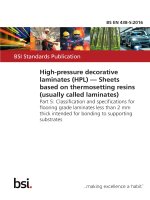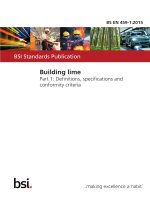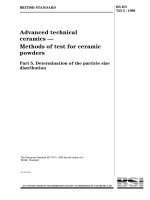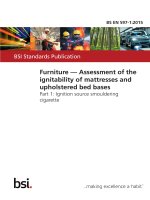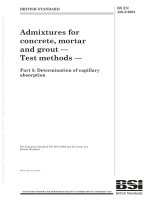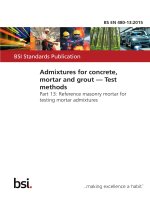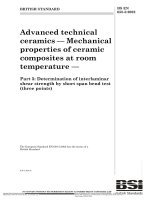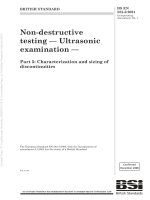Bsi bs en 62471 5 2015
Bạn đang xem bản rút gọn của tài liệu. Xem và tải ngay bản đầy đủ của tài liệu tại đây (2.16 MB, 58 trang )
BS EN 62471-5:2015
BSI Standards Publication
Photobiological safety of
lamps and lamp systems —
Part 5: Image projectors
BRITISH STANDARD
BS EN 62471-5:2015
National foreword
This British Standard is the UK implementation of EN 62471-5:2015. It is
identical to IEC 62471-5:2015.
The UK participation in its preparation was entrusted to Technical
Committee EPL/76, Optical radiation safety and laser equipment.
A list of organizations represented on this committee can be obtained on
request to its secretary.
This publication does not purport to include all the necessary provisions of
a contract. Users are responsible for its correct application.
© The British Standards Institution 2015.
Published by BSI Standards Limited 2015
ISBN 978 0 580 83757 9
ICS 29.140
Compliance with a British Standard cannot confer immunity from
legal obligations.
This British Standard was published under the authority of the
Standards Policy and Strategy Committee on 31 October 2015.
Amendments/corrigenda issued since publication
Date
Text affected
BS EN 62471-5:2015
EUROPEAN STANDARD
EN 62471-5
NORME EUROPÉENNE
EUROPÄISCHE NORM
October 2015
ICS 29.140
English Version
Photobiological safety of lamps and lamp systems - Part 5:
Image projectors
(IEC 62471-5:2015)
Sécurité photobiologique des lampes et des appareils
utilisant des lampes - Partie 5: Projecteurs d'images
(IEC 62471-5:2015)
Photobiologische Sicherheit von Lampen und
Lampensystemen - Teil 5: Photobiologische Sicherheit von
Lampensystemen für Bildprojektoren
(IEC 62471-5:2015)
This European Standard was approved by CENELEC on 2015-07-14. CENELEC members are bound to comply with the CEN/CENELEC
Internal Regulations which stipulate the conditions for giving this European Standard the status of a national standard without any alteration.
Up-to-date lists and bibliographical references concerning such national standards may be obtained on application to the CEN-CENELEC
Management Centre or to any CENELEC member.
This European Standard exists in three official versions (English, French, German). A version in any other language made by translation
under the responsibility of a CENELEC member into its own language and notified to the CEN-CENELEC Management Centre has the
same status as the official versions.
CENELEC members are the national electrotechnical committees of Austria, Belgium, Bulgaria, Croatia, Cyprus, the Czech Republic,
Denmark, Estonia, Finland, Former Yugoslav Republic of Macedonia, France, Germany, Greece, Hungary, Iceland, Ireland, Italy, Latvia,
Lithuania, Luxembourg, Malta, the Netherlands, Norway, Poland, Portugal, Romania, Slovakia, Slovenia, Spain, Sweden, Switzerland,
Turkey and the United Kingdom.
European Committee for Electrotechnical Standardization
Comité Européen de Normalisation Electrotechnique
Europäisches Komitee für Elektrotechnische Normung
CEN-CENELEC Management Centre: Avenue Marnix 17, B-1000 Brussels
© 2015 CENELEC All rights of exploitation in any form and by any means reserved worldwide for CENELEC Members.
Ref. No. EN 62471-5:2015 E
BS EN 62471-5:2015
EN 62471-5:2015
European Foreword
The text of document 76/519/FDIS, future edition 1 of IEC 62471-5, prepared by IEC/TC 76 "Optical
radiation safety and laser equipment" was submitted to the IEC-CENELEC parallel vote and approved
by CENELEC as EN 62471-5:2015.
The following dates are fixed:
–
latest date by which the document has to be implemented at
national level by publication of an identical national
standard or by endorsement
(dop)
2016-04-16
–
latest date by which the national standards conflicting with
the document have to be withdrawn
(dow)
2018-07-14
Attention is drawn to the possibility that some of the elements of this document may be the subject of
patent rights. CENELEC [and/or CEN] shall not be held responsible for identifying any or all such
patent rights.
Endorsement notice
The text of the International Standard IEC 62471-5:2015 was approved by CENELEC as a European
Standard without any modification.
2
BS EN 62471-5:2015
EN 62471-5:2015
Annex ZA
(normative)
Normative references to international publications
with their corresponding European publications
The following documents, in whole or in part, are normatively referenced in this document and are
indispensable for its application. For dated references, only the edition cited applies. For undated
references, the latest edition of the referenced document (including any amendments) applies.
NOTE 1 When an International Publication has been modified by common modifications, indicated by (mod), the relevant EN/HD
applies.
NOTE 2 Up-to-date information on the latest versions of the European Standards listed in this annex is available here:
www.cenelec.eu.
Publication
IEC 60050
IEC 60065
Year
series
-
IEC 60825-1
2014
IEC 60950-1
-
IEC 62471
-
Title
EN/HD
International Electrotechnical Vocabulary - Audio, video and similar electronicEN 60065
apparatus - Safety requirements
Safety of laser products -- Part 1:EN 60825-1
Equipment classification and requirements
Information technology equipment - SafetyEN 60950-1
-- Part 1: General requirements
Photobiological safety of lamps and lampEN 62471
systems
Year
series
2014
-
3
–2–
BS EN 62471-5:2015
IEC 62471-5:2015 © IEC 2015
CONTENTS
FOREWORD ......................................................................................................................... 5
INTRODUCTION ................................................................................................................... 7
1
Scope ............................................................................................................................ 8
2
Normative references..................................................................................................... 8
3
Terms and definitions .................................................................................................... 9
4
General ....................................................................................................................... 15
4.1
Basis for risk groups ........................................................................................... 15
4.2
Example applications .......................................................................................... 16
4.2.1
RG0 / RG1 projectors ................................................................................... 16
4.2.2
RG2 projectors ............................................................................................. 16
4.2.3
RG3 projectors ............................................................................................. 16
4.3
Projector lamps ................................................................................................... 16
4.4
Assessment criteria (background) ........................................................................ 16
5
Risk group determination ............................................................................................. 17
5.1
Test conditions .................................................................................................... 17
5.2
Measurement conditions for image projectors ...................................................... 18
5.2.1
Measurement throw ratio .............................................................................. 18
5.2.2
Measurement distance ................................................................................. 18
5.3
The position and size of apparent source, the calculation of angular
subtense ............................................................................................................. 18
5.4
Measurement of irradiance – specified apertures ................................................. 19
5.5
Measurement of radiance .................................................................................... 19
5.6
Accessible emission limits ................................................................................... 20
5.6.1
For CW emission.......................................................................................... 20
5.6.2
For pulsed emission ..................................................................................... 21
5.6.3
Spectral weighting functions ......................................................................... 22
5.7
Applying information from the lamp manufacturers ............................................... 23
5.7.1
General ....................................................................................................... 23
5.7.2
Limits provided in irradiance/radiant exposure .............................................. 24
5.7.3
Limits provided in radiance or radiance dose ................................................ 24
6
Manufacturer’s requirements ........................................................................................ 24
6.1
6.2
6.3
6.4
6.4.1
6.4.2
6.5
6.5.1
6.5.2
6.5.3
6.5.4
6.5.5
6.6
6.6.1
6.6.2
General ............................................................................................................... 24
Determination of HD (hazard distance) ................................................................ 25
Safety feature "soft start" .................................................................................... 25
Optional safety features ...................................................................................... 25
Projection of warning message ..................................................................... 25
Power reduction by sensor system ............................................................... 25
Labelling on products .......................................................................................... 25
General ....................................................................................................... 25
RG0 projector .............................................................................................. 26
RG1 projector .............................................................................................. 26
RG2 projector .............................................................................................. 27
RG3 projector .............................................................................................. 28
User information .................................................................................................. 28
General ....................................................................................................... 28
Assessment of user accessible area ............................................................. 29
BS EN 62471-5:2015
IEC 62471-5:2015 © IEC 2015
–3–
6.6.3
User information (user manual) .................................................................... 29
6.6.4
User information for maintenance ................................................................. 30
6.7
Labelling and user information for image projectors where the risk group will
be changed by interchangeable lens .................................................................... 30
6.7.1
General ....................................................................................................... 30
6.7.2
Labelling on the projector ............................................................................. 30
6.7.3
Mark on the interchangeable lens ................................................................. 32
6.7.4
The user information in the user manual of the projector ............................... 32
6.7.5
The user information in the user manual of the interchangeable lens ............. 32
7
Information for service ................................................................................................. 33
Annex A (normative) Test scheme for lamp types ............................................................... 34
Annex B (informative) Example of calculations ................................................................... 35
B.1
Radiance calculations ......................................................................................... 35
B.1.1
General ....................................................................................................... 35
B.1.2
Calculation from measured irradiance ........................................................... 35
B.1.3
Calculation from luminous output .................................................................. 36
B.2
Calculation example of risk group (CW) ............................................................... 37
B.2.1
Example of a 5 000 lm projector ................................................................... 37
B.2.2
10 000 lm professional-use projector with an apparent source of small
subtense angle (CW) .................................................................................... 39
B.2.3
2 000 lm projector with small apparent source (CW) ...................................... 40
B.3
Calculation example of risk group (pulsed emission) ............................................ 41
B.3.1
General ....................................................................................................... 41
B.3.2
14 000 lm projector with one peak ................................................................ 41
B.3.3
14 000 lm projector with two peaks ............................................................... 44
Annex C (informative) Example of intra-beam of projector sources with millimetre
scale .................................................................................................................................. 47
Annex D (informative) Measurement distance ..................................................................... 48
Annex E (informative) Hazard distance as a function of modifying optics ............................. 50
Bibliography ....................................................................................................................... 51
Figure 1 – Exit pupil in projector .......................................................................................... 10
Figure 2 – Examples of the application of the definition of pulse duration ............................. 13
Figure 3 – Definition of throw ratio....................................................................................... 15
Figure 4 – Diameter of the apparent source ......................................................................... 18
Figure 5 – RG1 label (optional) ........................................................................................... 26
Figure 6 – RG2 label ........................................................................................................... 27
Figure 7 – RG2 caution symbol ........................................................................................... 27
Figure 8 – Sample design of RG2 caution pictogram ............................................................ 27
Figure 9 – RG3 label ........................................................................................................... 28
Figure 10 – Optical radiation warning symbol ...................................................................... 28
Figure 11 – "Not for household use" symbol ........................................................................ 28
Figure 12 – RG2 label with the caution for RG3 ................................................................... 31
Figure 13 – RG2 caution label with the caution for RG3 ....................................................... 31
Figure 14 – RG2 pictogram with the caution for RG3 ........................................................... 32
Figure B.1 – Image of the apparent source and measurement condition ............................... 37
–4–
BS EN 62471-5:2015
IEC 62471-5:2015 © IEC 2015
Figure B.2 – Picture of the apparent source of a projector at the exit pupil of the
projection lenses with a scale .............................................................................................. 37
Figure B.3 – Example with one peak of pulsed emission ...................................................... 42
Figure B.4 – Example with two peaks of pulsed emission ..................................................... 44
Figure C.1 – Examples of intra-beam images of projector sources with millimetre scale ........ 47
Figure E.1 – Hazard distance as a function of modifying optics (example) ............................ 50
Table 1 – Measurement criteria — field of view (angles of acceptance) for CW source ......... 19
Table 2 – Measurement criteria — field of view (angles of acceptance) for pulsed
source ................................................................................................................................ 19
Table 3 – AEL (accessible emission limits) for risk groups of lamps and lamp systems
emitting CW optical radiation ............................................................................................... 20
Table 4 – Time base values associated with the risk groups and hazards ............................. 20
Table 5 – Basic retinal thermal emission limit ...................................................................... 20
Table 6 – The values of C 5 and α for AEL calculation .......................................................... 21
Table 7 – Pulse duration dependent values of α max ............................................................ 22
Table 8 – Spectral weighting functions B( λ ) and R( λ ) for assessing retinal hazards .............. 23
Table 9 – Labelling on products .......................................................................................... 26
Table 10 – User information in user manual ......................................................................... 29
Table A.1 –Required evaluations ......................................................................................... 34
BS EN 62471-5:2015
IEC 62471-5:2015 © IEC 2015
–5–
INTERNATIONAL ELECTROTECHNICAL COMMISSION
_____________
PHOTOBIOLOGICAL SAFETY OF LAMPS AND LAMP SYSTEMS –
Part 5: Image projectors
FOREWORD
1) The International Electrotechnical Commission (IEC) is a worldwide organization for standardization comprising
all national electrotechnical committees (IEC National Committees). The object of IEC is to promote
international co-operation on all questions concerning standardization in the electrical and electronic fields. To
this end and in addition to other activities, IEC publishes International Standards, Technical Specifications,
Technical Reports, Publicly Available Specifications (PAS) and Guides (hereafter referred to as “IEC
Publication(s)”). Their preparation is entrusted to technical committees; any IEC National Committee interested
in the subject dealt with may participate in this preparatory work. International, governmental and nongovernmental organizations liaising with the IEC also participate in this preparation. IEC collaborates closely
with the International Organization for Standardization (ISO) in accordance with conditions determined by
agreement between the two organizations.
2) The formal decisions or agreements of IEC on technical matters express, as nearly as possible, an international
consensus of opinion on the relevant subjects since each technical committee has representation from all
interested IEC National Committees.
3) IEC Publications have the form of recommendations for international use and are accepted by IEC National
Committees in that sense. While all reasonable efforts are made to ensure that the technical content of IEC
Publications is accurate, IEC cannot be held responsible for the way in which they are used or for any
misinterpretation by any end user.
4) In order to promote international uniformity, IEC National Committees undertake to apply IEC Publications
transparently to the maximum extent possible in their national and regional publications. Any divergence
between any IEC Publication and the corresponding national or regional publication shall be clearly indicated in
the latter.
5) IEC itself does not provide any attestation of conformity. Independent certification bodies provide conformity
assessment services and, in some areas, access to IEC marks of conformity. IEC is not responsible for any
services carried out by independent certification bodies.
6) All users should ensure that they have the latest edition of this publication.
7) No liability shall attach to IEC or its directors, employees, servants or agents including individual experts and
members of its technical committees and IEC National Committees for any personal injury, property damage or
other damage of any nature whatsoever, whether direct or indirect, or for costs (including legal fees) and
expenses arising out of the publication, use of, or reliance upon, this IEC Publication or any other IEC
Publications.
8) Attention is drawn to the Normative references cited in this publication. Use of the referenced publications is
indispensable for the correct application of this publication.
9) Attention is drawn to the possibility that some of the elements of this IEC Publication may be the subject of
patent rights. IEC shall not be held responsible for identifying any or all such patent rights.
International Standard IEC 62471-5 has been prepared by IEC technical committee 76:
Optical radiation safety and laser equipment.
The text of this standard is based on the following documents:
FDIS
Report on voting
76/519/FDIS
76/521/RVD
Full information on the voting for the approval of this standard can be found in the report on
voting indicated in the above table.
This publication has been drafted in accordance with the ISO/IEC Directives, Part 2.
–6–
BS EN 62471-5:2015
IEC 62471-5:2015 © IEC 2015
The committee has decided that the contents of this publication will remain unchanged until
the stability date indicated on the IEC web site under "" in the data
related to the specific publication. At this date, the publication will be
•
reconfirmed,
•
withdrawn,
•
replaced by a revised edition, or
•
amended.
A bilingual version of this publication may be issued at a later date.
IMPORTANT – The 'colour inside' logo on the cover page of this publication indicates
that it contains colours which are considered to be useful for the correct
understanding of its contents. Users should therefore print this document using a
colour printer.
BS EN 62471-5:2015
IEC 62471-5:2015 © IEC 2015
–7–
INTRODUCTION
Most lamps and lamp systems are safe and do not pose photobiological risks except under
unusual exposure conditions. This also is the case for optical image projectors where
experience shows that even high power cinema projectors may be safe for accidental
momentary viewing and can only under some conditions pose optical hazards at close
distances or for intentional 'long-duration' staring into the source. The rapid development of
solid-state and other lamps or lamp systems has permitted new projector products, and
generated the need for a photobiological safety standard for this group of lamp systems.
Optical radiation hazards from all types of lamps and lamp systems are currently assessed by
the application of IEC 62471:2006 (CIE S 009:2002), Photobiological safety of lamps and
lamp systems. IEC 62471 covers LEDs, incandescent, low- and high-pressure gas-discharge,
arc and other lamps. Following the concept of vertical standards, the risk group classification
system in IEC 62471 for lamps is to be adapted for specific product groups such as image
projectors.
This part of IEC 62471 provides a risk group classification system for image projectors, and
measurement conditions for optical radiation emitted by image projectors. It includes
manufacturing requirements that may be required as a result of an image projector system
being assigned to a particular risk group. Therefore, this part of IEC 62471 provides safety
requirements for lamp systems that are intended to produce projected visible optical radiation,
such as theatre projectors, data projectors and home-use projectors. The assigned risk group
of a projector product also may be used by projector manufacturers to assist with any risk
assessments, e.g. for occupational exposure in workplaces. National requirements may exist
for the assessment of products or occupational exposure.
The emission limits provided in this part of IEC 62471 are derived from the exposure limits
specified by ICNIRP in their 2013 Guidelines for incoherent visible and infrared radiation [1] 1.
These exposure limits are also the basis for the emission limits to be specified in the future
International Standard IEC 62471-1 2.
______________
1
Numbers in square brackets refer to the Bibliography.
2
Revision of IEC 62471:2006.
–8–
BS EN 62471-5:2015
IEC 62471-5:2015 © IEC 2015
PHOTOBIOLOGICAL SAFETY OF LAMPS AND LAMP SYSTEMS –
Part 5: Image projectors
1
Scope
This part of IEC 62471 provides requirements regarding photobiological safety of the optical
radiation emitted by image projectors. This part of IEC 62471 does not deal with other
hazards such as electrical, mechanical or fire hazards.
This part of IEC 62471 provides requirements regarding:
•
optical radiation safety assessment of image projectors;
•
projector risk groups;
•
testing conditions and measurement conditions;
•
manufacturer’s requirements including user information.
The scope of this part of IEC 62471 is photobiological safety of image projectors including the
emissions from laser-illuminated projectors that fulfill the requirements as specified in
IEC 60825-1:2014, 4.4 and for which visible light emission has been excluded from
classification in IEC 60825-1.
This part of IEC 62471 does not address safety requirements for laser display products where
collimated laser beams — generally scanned — are employed. It does address those laserilluminated projectors that employ a laser source to illuminate, for example, a micro-electromechanical system (MEMS) without scanned beams or crystal-based display projector system.
NOTE Image projectors containing lasers are subject to those provisions of IEC 60825-1 applicable to the
embedded laser. See IEC 60825-1:2014, 4.4 for which visible light emission has been excluded from the laser
product classification.
This part of IEC 62471 includes projectors for only visible image projection and does not
include ultraviolet (UV) projectors, infrared (IR) projectors, general lighting service (GLS)
lamps (GLS; defined in IEC 62471) or projector lamp systems used for general lighting, which
are treated in separate International Standards.
2
Normative references
The following documents, in whole or in part, are normatively referenced in this document and
are indispensable for its application. For dated references, only the edition cited applies. For
undated references, the latest edition of the referenced document (including any
amendments) applies.
IEC 62471, Photobiological safety of lamps and lamp systems
IEC 60825-1:2014, Safety of laser products – Part 1: Equipment classification and
requirements
IEC 60050
(all
parts),
International
)
Electrotechnical
Vocabulary
(available
IEC 60950-1, Information technology equipment – Safety – Part 1: General requirements
at
BS EN 62471-5:2015
IEC 62471-5:2015 © IEC 2015
–9–
IEC 60065, Audio, video and similar electronic apparatus – Safety requirements
3
Terms and definitions
For the purposes of this document, the terms and definitions given in IEC 62471,
IEC 60050-845 [2] and the following apply.
3.1
accessible emission
AE
level of radiation determined at a certain distance from the product and with measurement
conditions described in Clause 5
Note 1 to entry:
product.
The accessible emission is compared with the AEL (see 3.2) to determine the risk group of the
3.2
accessible emission limit
AEL
maximum accessible emission permitted within a particular risk group
3.3
angle of acceptance
γ
plane angle within which a detector will respond to optical radiation
Note 1 to entry:
The angle of acceptance is usually measured in radians (SI unit).
Note 2 to entry: This angle of acceptance may be controlled by apertures or optical elements in front of the
detector. The angle of acceptance is also sometimes referred to as the field of view (see 3.12).
Note 3 to entry: The angle of acceptance should not be confused with the angular subtense of the source
(see 3.4) or the beam divergence.
3.4
angular subtense
α
visual angle subtended by the apparent source at the eye of an observer or at the point of
measurement
Note 1 to entry:
angle.
In this part of IEC 62471, subtended angles are denoted by the full included angle, not the half
Note 2 to entry:
SI unit: radian.
Note 3 to entry: The angular subtense α may be modified by incorporation of lenses and mirrors as projector
optics, i.e. the angular subtense of the apparent source may differ from the angular subtense of the physical
source.
Note 4 to entry:
The limitations of α in this part of IEC 62471 are:
For continuous wave: α max = 0,1 rad, α min = 0,001 5 rad.
For pulsed emission: α max is described in Table 7, α min = 0,001 5 rad.
3.5
cinema-use projector
image projector used for projection in theatrical environment
3.6
consumer product
item intended for consumers or likely to be used by consumers, even if not intended for them
– 10 –
BS EN 62471-5:2015
IEC 62471-5:2015 © IEC 2015
Note 1 to entry: Products provided in the framework of a service to consumers are also considered to
be consumer products.
Note 2 to entry:
RG3 products are intended for professional use only, and are not intended for consumer use.
3.7
continuous wave emission
CW emission
emission of a projector which can be considered continuous when the output is continuous for
times greater than 0,25 s and the peak radiated power is not higher than 1,5 times the
average radiated power
3.8
data projector
image projector system using digital imager(s) routinely employed in offices, meetings and
sales presentations
Note 1 to entry:
Examples of data imager are MEMS and liquid crystal based display.
3.9
exit pupil
image of the aperture stop which also functions as a virtual aperture of the projection lens
Note 1 to entry:
(see Figure 1).
The position of the apparent source is located at the apparent position of the exit pupil
Lens front
Imager
Exit pupil
Aperture stop
Screen
Origin of measurement
distance (see 5.2.2)
Distance used for “Throw Ratio”
Projection lens
Projector
IEC
Figure 1 – Exit pupil in projector
3.10
exposure limit
EL
maximum level of exposure of optical radiation to the eye or skin that is not expected to result
in adverse biological effects
Note 1 to entry:
These ELs are used to determine hazard distances with respect to photobiological effects.
3.11
exposure to limit ratio
ELR
ratio of the exposure level and the exposure limit
BS EN 62471-5:2015
IEC 62471-5:2015 © IEC 2015
– 11 –
Note 1 to entry: Since both values can be functions of distance and exposure duration, the ELR can depend on
exposure distance and exposure duration.
3.12
field of view
γ
solid angle as "seen" by the detector (acceptance angle), for example of a radiometer or
spectroradiometer, out of which the detector receives radiation
Note 1 to entry:
SI unit: steradian (sr).
Note 2 to entry:
The field of view should not be confused with the angular subtense of the apparent source, α.
Note 3 to entry:
A plane angle is sometimes used to describe a circular symmetric solid angle field of view.
Note 4 to entry:
The field of view is sometimes referred to as angle of acceptance (see 3.3).
3.13
fixed projector installation
projector installed permanently or semi-permanently in a fixed location
EXAMPLE
A cinema-use projector mounted in an operating booth.
3.14
hazard distance
HD
distance from the projector's nearest point of human access, where the beam radiance or
irradiance exceeds the applicable exposure limit (EL: see 3.10)
Note 1 to entry: The hazard distance for a projector is determined by the EL for a 0,25 s exposure. This also is
the time base of the accessible emission limit of RG2.
3.15
home-use projector
image projector used for audio-visual presentations in the domestic environment under noncontrolled conditions and non-professional use
3.16
image projector product
member of the family of products that includes all types of image projectors such as data
projectors (see 3.8), home-use projectors (see 3.15) and cinema-use projectors (see 3.5)
3.17
intended use
usage of a product, process or application in accordance with specifications, instructions and
information provided by the manufacturer or supplier
3.18
lamp
electrically powered device emitting optical radiation in the wavelength range between 200 nm
and 3 000 nm, with the exception of direct, non-diffuse laser radiation
3.19
lamp system
electrically operated product incorporating lamp(s), including fixtures, projection optics and
incorporated electrical or electronic components as intended by the manufacturer
Note 1 to entry: A lamp system can include diffusers, enclosures and/or beam modifying optics. An image
projector (see 3.16) is a type of lamp system.
– 12 –
BS EN 62471-5:2015
IEC 62471-5:2015 © IEC 2015
3.20
laser illuminated projecting system
LIP system
projection lamp system emitting visible diffused light as a result of laser light source(s) in
order to replace traditional projector lamps
3.21
light emitting diode
LED
solid-state lamp device embodying a p-n junction, emitting incoherent optical radiation when
excited by an electric current
3.22
liquid-crystal display projector
LCD projector
projector employing an LCD digitized image panel that is projected by the system
3.23
micro-electro-mechanical system based imager
MEMS based imager
micro-electro-mechanical system with electro-optical arrays of micro-mirrors
3.24
modifying optics
optical components that process the light, such as filters, lenses and reflectors, which change
the characteristics of the optical radiation from the initial light source when incorporated into
an image projector (see 3.16)
3.25
projector
optical system using reflection and/or refraction to increase the luminous intensity within a
limited solid angle
Note 1 to entry:
The light emitted into a limited solid-angle is generally referred to as the “beam”.
Note 2 to entry: The emitted beam is intended to be incident on a screen or some other diffuse surface such as a
house or room wall.
3.26
projector lamp
lamp in which the luminous element is mounted in such a way that the lamp may be used with
an optical system to project the light in chosen directions
3.27
pulse duration
tp
time increment calculated by D/L peak where D is the total radiance dose of the pulse and
L peak is the peak radiance of that pulse (see Figure 2)
BS EN 62471-5:2015
IEC 62471-5:2015 © IEC 2015
– 13 –
D (total radiance dose of the pulse)
D (total radiance dose of the pulse)
tp = D / Lpeak
tp = D / Lpeak
Lpeak
Lpeak
1 cycle
1 cycle
IEC
Figure 2 – Examples of the application of the definition of pulse duration
Note 1 to entry:
Unit: second (s).
Note 2 to entry: For a pulse that has a triangular or rectangular temporal emission shape, this definition of pulse
duration is identical to the full-width-half-maximum (FWHM) definition.
Note 3 to entry: A rectangular pulse, shown with dashed borders in Figure 2, with the pulse duration t p has the
same radiance dose and peak radiance as the actual pulse.
3.28
pulsed emission
emission in the form of a single pulse or a train of pulses where each pulse is assumed to have
a duration of less than 0,25 s
Note 1 to entry: Pulsed emission refers to a product with a continuous train of pulses or modulated radiant energy
where the peak radiated power is at least 1,5 times higher than the average radiated power.
3.29
radiance
L
quantity defined by the formula
L = dΦ/(dA ⋅ cosθ ⋅ d Ω )
in a given direction at a given point of a real or imaginary surface,
where
dΦ
is the radiant power (flux) transmitted by an elementary beam passing through the given
point and propagating in the solid angle (d Ω ) containing the given direction;
dA
is the area of a section of that beam containing the given point;
θ
is the angle between the normal to that section and the direction of the beam
Note 1 to entry:
SI unit: watt per square metre per steradian (W·m - 2 ·sr - 1 ).
3.30
radiance dose
D
time integrated radiance quantity defined by the equation
D = dQ e /(dA ⋅ cosθ ⋅ d Ω )
where
dQ e is the radiant energy transmitted by an elementary beam passing through the given
point and propagating in the solid angle (d Ω ) containing the given direction;
dA
is the area of a section of that beam containing the given point;
– 14 –
θ
BS EN 62471-5:2015
IEC 62471-5:2015 © IEC 2015
is the angle between the normal to that section and the direction of the beam
Note 1 to entry:
SI unit: joule per square metre per steradian (J·m -2 ·sr -1 ).
Note 2 to entry:
Equivalent term: “(time) integrated radiance”.
3.31
restricted area
area where an engineering and/or administrative control measure is established to restrict
access except to authorized personnel with appropriate safety training
Note 1 to entry:
Access is only possible through the use of a tool, lock, key or other means of security.
3.32
spatially averaged radiance
L sa
quantity defined by the equation
L sa = dΦ/(dA γ ⋅cosθ ⋅ d Ω )
radiance spatially averaged over a given angle of acceptance to account for physiological
factors such as eye-movements (sometimes referred to as “physiological radiance”)
where
dΦ
is the radiant power (flux);
dA γ
is limited by area of field of view (see 3.12);
θ
is the angle between the normal to that section and the direction of the beam;
dΩ
is the solid angle
Note 1 to entry:
SI unit: watt per square metre per steradian (W·m -2 ·sr -1 ).
Note 2 to entry:
The spatially averaged radiance may be lower than the true source radiance (see 3.34).
3.33
throw ratio
TR
ratio between the distance from the exit pupil to the screen and the width of the image on the
screen
Note 1 to entry: It is thus approximated by the inverse of the tangent of the full angle of the light beam in the
horizontal direction (see Figure 3).
BS EN 62471-5:2015
IEC 62471-5:2015 © IEC 2015
– 15 –
lb : Lens front - Apparent source
la : Projection distance
Lens front
Apparent source
(Exit pupil)
W: Projection width
IEC
Figure 3 – Definition of throw ratio
Note 2 to entry:
TR = (l a + l b )/W.
3.34
true source radiance
L
radiance of the emitting element of the source, physically measured
Note 1 to entry: The applicable averaging angle of acceptance for the determination of radiance shall not be
larger than 1,5 mrad.
Note 2 to entry:
SI unit: watt per square metre per steradian (W·m -2 ·sr -1 ).
Note 3 to entry: This definition differs from spatially averaged radiance (see 3.32). This is a quantity that is useful
as information regarding the projector light source (see 5.7.3). For the spatially averaged radiance, the given angle
of acceptance should have a value as defined in Table 1 or Table 2. This value is defined based on physiological
factors. While the true source radiance should be averaged over a small angle in order to be more accurate, the
maximum allowed averaging angle is defined to 1,5 mrad.
3.35
unintentional viewing
condition when ocular exposure to optical radiation is not intended
4
4.1
General
Basis for risk groups
IEC 62471 provides the default method to determine the risk group of any lamp or any product
incorporating a lamp, unless a vertical (application-specific) standard exists. The risk groups
in IEC 62471 indicate the degree of risk from potential optical radiation hazards and minimize
the need for further measurements. The risk groups were developed based upon decades of
lamp use experience and the analysis of accidental injuries related to optical radiation
emission (where injuries were generally quite rare except from, for example, ultravioletemitting lamps or arc lamps).
The risk groups are described as follows:
•
Exempt Group (RG0) where no optical hazard is considered reasonably foreseeable, even
for continuous, unrestricted use.
•
Risk Group 1 (RG1) products are safe for most applications, except for very prolonged
direct ocular exposures (staring into the source for very long times, greater than 100 s).
16
BS EN 62471-5:2015
IEC 62471-5:2015 â IEC 2015
ã
Risk Group 2 (RG2) products do not pose an optical hazard because of aversion
responses to bright light which make long exposures (staring into the source) not
reasonably foreseeable. RG2 projectors can be safely used in all situations, except if
intrabeam (direct) viewing is intended.
•
Risk Group 3 (RG3) products pose a potential hazard even for momentary exposures at
close distance and product safety requirements are generally essential. RG3 projectors
pose a risk resulting from direct, intra-beam viewing at close distance. User information on
protective measures shall be provided. The RG3 projector products require controlled use
or special installation (for example, theatre projectors), and user instructions should
clearly state the HD and the requirement for supervised use or special installation. From
the labelling and information for the user, the user should recognize the risk and take
protective measures.
RG3 products are intended for professional use only, and are not intended for consumer
use.
4.2
4.2.1
Example applications
RG0 / RG1 projectors
Typical examples are conventional tungsten halogen slide or film projectors for home use or
pico-projectors.
4.2.2
RG2 projectors
For example, home-use projectors or mobile projectors may be RG2 projectors.
4.2.3
RG3 projectors
For example, high luminance projection systems used in cinemas or theatres may be RG3
projectors. Rental projectors for professional staging applications, seminars and other big
events may also be RG3 projectors.
4.3
Projector lamps
It should be noted that the risk group classification system of IEC 62471 in its current version
is primarily applied to lamps. However, manufacturers of image projectors have the
responsibility for assessing the final product. They may have limited capabilities for tests and
measurements and may need to rely on the lamp data provided by the lamp manufacturer.
Therefore, guidance is provided in 5.7 on how and when projector system manufacturers may
rely on data provided by the lamp manufacturer.
4.4
Assessment criteria (background)
The standard measurement conditions consider the emission spectrum and, depending on the
hazard, either irradiance or spatially averaged radiance to determine risk to the eye and/or
the skin. The measurement conditions are related to potentially hazardous exposure
conditions and potential direct-viewing conditions and take into consideration physiological
factors of the eye, such as accommodation, pupil size and the aversion response.
Assessment and measurement conditions necessarily differ for different special application
lamp systems, such as image projector products. Different application groups define a range
of operational, maintenance and servicing conditions. The assessment applied to image
projectors (as a specific type of lamp system) in this vertical standard justifies somewhat
different measurement conditions than those in IEC 62471 for lamps. The requirements in this
application-specific (vertical) standard limit the product risk group that can be used in some
specific applications, such as in domestic environments or in schools. Performance features
are based upon the risk group specifications and application-specific control measures. Basic
guidance, based on the likelihood of direct source viewing, is provided in Clause 6. The
hierarchy of applicable safety measures follow the internationally accepted priority ranking of
manufacturer safety measures. Engineering controls (filters, shielding, etc.) have the highest
BS EN 62471-5:2015
IEC 62471-5:2015 © IEC 2015
– 17 –
priority, followed by collective organizational measures, and finally, only if the above
measures are not practical to reduce the risk to a tolerable level, personal protective
equipment.
Multiple limit values are specified in this safety standard to reflect different photobiological
hazards. Each of these limits, in principle, must be evaluated against the respective
accessible emission separately (see Annex A). The limit values are expressed as irradiance
or radiance.
Each risk group is associated with different time bases as found in Table 4.
To determine the risk group, the accessible emission must be first determined and then the
accessible emission is compared against the AEL values provided in Table 3 for the time
bases provided in Table 4 (see Annex B).
•
The product is RG0 (Exempt Group) if no accessible emission exceeds the RG0 AELs.
•
The product is RG1 if any accessible emission exceeds the RG0 AELs but no accessible
emission exceeds the RG1 AELs.
•
The product is RG2 if any accessible emission exceeds the RG1 AELs but no accessible
emission exceeds the RG2 AELs.
•
The product is RG3 if any accessible emission exceeds the RG2 AELs. If an image
projector is to be assigned to RG3, the AE for UV, UV-A and IR shall be below the AEL for
RG2 (see 6.1).
5
5.1
Risk group determination
Test conditions
The image projector shall meet the safety requirements defined in this part of IEC 62471
under all expected operating conditions appropriate to the intended use of the product.
Factors to be considered shall include:
•
climatic conditions (for example temperature, relative humidity);
•
vibration and shock.
If no provisions are made in a specific product safety standard, the relevant subclauses of
IEC 60950-1 and/or IEC 60065 shall apply.
The product shall be adjusted to achieve the maximum emission. The light source shall be
operated at maximum optical power output. For image projectors this means that modulation,
colour and spatial characteristics should be chosen to achieve the highest radiant power.
The evaluation shall include reasonably foreseeable single fault conditions such as failure of
diffusers or light-beam processing optics prior to the projection lens or circuit failure. The
accessible emission of the image projector shall not exceed the AEL of the assigned RG
under any reasonably foreseeable single fault. The concepts of risk analysis should be
applied to characterize if a given fault is reasonably foreseeable or not.
It is not mandatory to measure the accessible emission or the angular subtense of the
apparent source (as parameter of the AEL). These parameters can also be determined by
calculation, or they can be inferred from information provided by the lamp manufacturer (see
5.7). Also, depending on the type of light source, some accessible emission values
(depending on associated wavelength range) need not be determined as specified
in Table A.1.
– 18 –
5.2
5.2.1
BS EN 62471-5:2015
IEC 62471-5:2015 © IEC 2015
Measurement conditions for image projectors
Measurement throw ratio
Fixed focal length projector systems that have no adjustable zoom shall be measured with the
focus adjusted to achieve maximum radiance.
Projectors with an adjustable throw ratio (zoom) lens that is non-interchangeable shall be
adjusted to achieve the highest ratio between the radiance and AEL.
Projectors with an interchangeable lens system shall be tested with the throw ratio adjusted to
2,0 or higher.
5.2.2
Measurement distance
The accessible emission shall be determined at a distance of 1,0 m from the closest point of
human access toward the light source along the axis of the light beam (see Annex D).
5.3
The position and size of apparent source, the calculation of angular subtense
In this part of IEC 62471, the position of apparent source is defined as the location of the exit
pupil of the projection lens.
The diameter is defined by using the 'Full Width at Half Maximum' (FWHM) (see Figure 4).
Maximum
50 % of
maximum
Diameter of the apparent source
(by way of full width at half maximum)
IEC
Figure 4 – Diameter of the apparent source
If the exit pupil is fully filled with an irradiance pattern (flashed), the outer diameters of the
exit pupil can be used to determine the angular subtense α as seen from the measurement
distance (see Annex C).
The AEL for the retinal thermal hazard depends on the parameter α, the angular subtense of
the apparent source (see 3.4). The angular subtense of the apparent source is calculated by
using the distance from the observer to the apparent source. If the radiance (AE to be
compared with the retinal thermal AEL) is determined with an 11 mrad averaging angle of
acceptance, then the minimum value of α for the determination of the AEL is 11 mrad. If the
radiance is determined with an averaging angle of acceptance of 5 mrad (for instance for
pulsed emission), the minimum value of α for the determination of AEL shall not be less than
5 mrad.
The angular subtense of an oblong source shall be determined by the arithmetic mean of the
maximum and minimum angular dimensions of the source. For example, for a 20 mm long by
10 mm diameter tubular source at a viewing distance of l = 1 m in a direction normal to the
lamp axis, it would be determined from the mean dimension, Z;
BS EN 62471-5:2015
IEC 62471-5:2015 © IEC 2015
– 19 –
Z = (20 + 10) / 2 = 15 mm (0,015 m).
Thus
α = Z /l = 0,015 / 1 = 0,015 rad.
Any angular dimension larger than α max shall be limited to α max and any angular dimension
smaller than α min shall be limited to α min , prior to the determination of the arithmetic mean.
NOTE
In this part of IEC 62471, the value for α min is 0,001 5 rad.
5.4
Measurement of irradiance – specified apertures
Where the limits in IEC 62471 are provided in irradiance or radiant exposure, the angle of
acceptance values are specified in Table 1.
Measurements of irradiance shall be made to include localized areas of highest irradiance
within the beam cross-section. On condition the irradiance profile in the beam for a white
image can be assumed to be homogeneous (constant irradiance profile), the diameter of the
aperture stop over which irradiance is averaged is not critical. A larger aperture stop can be
used to improve the signal to noise ratio. Typical input optics diameters are 20 mm, but as
long as a uniform irradiance profile is ensured aperture stop diameters up to 50 mm can be
used.
5.5
Measurement of radiance
In cases where the limits are provided as radiance or radiance dose to be compared to AE
that is spatially averaged radiance, the source radiance data shall be determined with
projector focus and throw ratio setting as specified in 5.2.1. The field of view (averaging angle
of acceptance of the radiance detector) is given in Table 1 for CW emission and in Table 2 for
pulsed emission. The area of the source producing the maximum spatial radiance (hotspot)
shall be determined.
Table 1 – Measurement criteria — field of view (angles of acceptance) for CW source
Angle of acceptance γ, rad
Hazard name
Wavelength
range, nm
Exempt Group
Risk Group 1
Risk Group 2
UV
200 to 400
1,4
1,4
1,4
UV-A
315 to 400
1,4
1,4
1,4
Blue-light
300 to 700
0,11
0,011
0,011
Retinal thermal
380 to 1 400
0,011
0,011
0,011
Corneal/lens IR
780 to 3 000
1,4
1,4
1,4
Table 2 – Measurement criteria — field of view (angles of acceptance) for pulsed source
Angle of acceptance γ, rad
Hazard name
Wavelength
range, nm
Exempt Group
Risk Group 1
Risk Group 2
UV
200 to 400
1,4
1,4
1,4
UV-A
315 to 400
1,4
1,4
1,4
Blue-light
300 to 700
0,11
0,011
0,011
Retinal thermal
380 to 1 400
0,005
0,005
0,005
Corneal/lens IR
780 to 3 000
1,4
1,4
1,4
BS EN 62471-5:2015
IEC 62471-5:2015 © IEC 2015
– 20 –
5.6
Accessible emission limits
5.6.1
For CW emission
When the output is continuous for times greater than 0,25 s and the peak radiated power is
not higher than 1,5 times the average radiated power, the pulse criteria defined in 5.6.2 need
not be applied. In this case, the AE for the retinal thermal hazard is determined as average
radiance (averaged over 0,25 s) and is compared with the CW-AEL for the retinal thermal
hazard specified in Table 3 (see 3.7).
Table 3 – AEL (accessible emission limits) for risk groups of lamps
and lamp systems emitting CW optical radiation
Emission limits
Hazard
Wavelength
range, nm
Symbol
for
emission
level 1
Exempt
Group
Risk Group
1
Risk Group
2
Units
UV 2
200 to 400
ES
0,001
0,003
0,03
W∙m -2
UV-A2
315 to 400
E UVA
10
33
100
W∙m -2
Blue-light
300 to 700
LB
100
10 000
4 000 000
W∙m -2 ∙sr -1
Blue-light small
source
300 to 700
EB
1,0
1,0
400
W∙m -2
Retinal thermal
380 to 1 400
LR
28 000/α
28 000/α
28 000/α
W∙m -2 ∙sr -1
IR anterior eye 2
780 to 3 000
E IR
100
570
3200
W∙m -2
1
Symbols for emission levels (E S , E UVA , L B , E B , L R , E IR ) and each formula are defined in IEC 62471. Some
formulae of above emission levels are defined by using weighting functions B(λ) and R(λ) (see Table 8).
2
For an image projector that is to be assigned to RG3, the AE for UV, UV-A and IR shall not exceed the AEL
for RG2
Table 4 – Time base values associated with the risk groups and hazards
Hazard
Exempt Group
Risk Group 1
Risk Group 2
UV
30 000 s
10 000 s
1 000 s
UV-A
1 000 s
300 s
100 s
Retinal blue-light
10 000 s
100 s
0,25 s
Retinal thermal
0,25 s
0,25 s
0,25 s
Infrared cornea
1 000 s
100 s
10 s
Table 5 – Basic retinal thermal emission limit
Exposure duration t
t ≤ 1 µs
1 µs < t ≤ 0,25 s
t > 0,25 s
Radiance L R EL
0,63
α -1 ∙t -1
Unit
W∙m -2 ∙sr -1
2,0 × 10 4 ∙α -1 ∙t -0,25
W∙m -2 ∙sr -1
Determined as CW
The angular subtense of the apparent source α is expressed in radians, and t is expressed in seconds.
The value of α in the determination of the AEL shall not be less than α min and not be larger than α max.
BS EN 62471-5:2015
IEC 62471-5:2015 © IEC 2015
5.6.2
– 21 –
For pulsed emission
5.6.2.1
General
The emission should be considered to be pulsed if the peak radiated power is more than 1,5
times the average radiated power (see 3.28).
5.6.2.2
For UV, UV-A, photochemical retinal limits and IR cornea limit
Compare the averaged irradiance or averaged radiance with the AEL values of Table 3
(averaging over the time base associated with the risk group and respective limit, see
Table 4).
5.6.2.3
For retinal thermal limit
For projectors emitting pulsed optical radiation, the classification criteria shall apply to the
most restrictive of the requirements for a single pulse, or to any group of pulses.
The criteria below apply to the general case of pulsed emission.
In the general case, two criteria apply, and the respective accessible emission shall not
exceed the AEL for either of the two criteria a) and b) as follows.
a) Compare the averaged radiance with the AEL values of Table 5.
(a-1) For regularly emitted pulse trains (constant pulse parameters), average over the time
base of 0,25 s.
(a-2) For irregular pulse patterns, average over emission durations that are shorter than or
equal to 0,25 s in order to also analyse groups of pulses.
b) Compare the peak radiance of each pulse with the AEL values of Table 5. The AEL values
shall be multiplied by the factor C 5 in Table 6.
The pulse duration is defined as: t p = D/L peak (see 3.27).
And the value of α used in the calculation of the AEL is defined in Table 6.
Table 6 – The values of C 5 and α for AEL calculation
Value of C 5
Value of α for calculating AEL
1,0
0,005 rad
N ≤ 40
N -0,25
α
N > 40
0,4
α
N ≤ 625
N -0,25
α max
N > 625
0,2
α max
1,0
α max
Condition
α ≤ 0,005 rad
0,005 rad < α ≤ α max
α max < α < 0,1 rad
α ≥ 0,1 rad
N is the number of pulses that occur within the time base.
α max is defined in Table 7.
